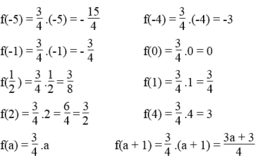Hãy nhập câu hỏi của bạn vào đây, nếu là tài khoản VIP, bạn sẽ được ưu tiên trả lời.

Câu 1:
a)
| \(y=f\left(x\right)=2x^2\) | -5 | -3 | 0 | 3 | 5 |
| f(x) | 50 | 18 | 0 | 18 | 50 |
b) Ta có: f(x)=8
\(\Leftrightarrow2x^2=8\)
\(\Leftrightarrow x^2=4\)
hay \(x\in\left\{2;-2\right\}\)
Vậy: Để f(x)=8 thì \(x\in\left\{2;-2\right\}\)
Ta có: \(f\left(x\right)=6-4\sqrt{2}\)
\(\Leftrightarrow2x^2=6-4\sqrt{2}\)
\(\Leftrightarrow x^2=3-2\sqrt{2}\)
\(\Leftrightarrow x=\sqrt{3-2\sqrt{2}}\)
hay \(x=\sqrt{2}-1\)
Vậy: Để \(f\left(x\right)=6-4\sqrt{2}\) thì \(x=\sqrt{2}-1\)

a: \(f\left(x\right)=4x+a-\sqrt{3}\left(2x+1\right)\)
\(=4x+a-2\sqrt{3}\cdot x-\sqrt{3}\)
\(=x\left(4-2\sqrt{3}\right)-\sqrt{3}+a\)
Vì \(4-2\sqrt{3}=\left(\sqrt{3}-1\right)^2>0\)
nên hàm số \(y=f\left(x\right)=x\left(4-2\sqrt{3}\right)+a-\sqrt{3}\) luôn đồng biến trên R
b: f(x)=0
=>\(x\left(4-2\sqrt{3}\right)+a-\sqrt{3}=0\)
=>\(x\left(4-2\sqrt{3}\right)=-a+\sqrt{3}\)
=>\(x=\dfrac{-a+\sqrt{3}}{4-2\sqrt{3}}\)

a: f(a)=g(a)
=>5a-3=-1/2a+1
=>5,5a=4
=>\(a=\dfrac{4}{5.5}=\dfrac{8}{11}\)
b: f(b-2)=g(2b+4)
=>\(5\left(b-2\right)-3=-\dfrac{1}{2}\left(2b+4\right)+1\)
=>\(5b-13=-b-2+1=-b-1\)
=>6b=12
=>b=2
f(a) = g(a)
⇔ 5a - 3 = -a/2 + 1
⇔ 5a + a/2 = 1 + 3
⇔ 11a/2 = 4
⇔ 11a = 8
⇔ a = 8/11
Vậy a = 8/11 thì f(a) = g(a)
b) f(b - 2) = g(2b + 4)
⇔ 5.(b - 2) - 3 = -(2b + 4)/2 + 1
⇔ 5b - 10 - 3 = -b - 2 + 1
⇔ 5b + b = 1 + 13
⇔ 6b = 14
⇔ b = 7/3
Vậy b = 7/3 thì f(b - 2) = g(2b + 4)

\(a,f\left(-2\right)=\dfrac{3}{4}\left(-2\right)=-\dfrac{3}{2}\\ f\left(0\right)=\dfrac{3}{4}\cdot0=0\\ f\left(1\right)=\dfrac{3}{4}\cdot1=\dfrac{3}{4}\\ b,g\left(-2\right)=\dfrac{3}{4}\left(-2\right)+3=-\dfrac{3}{2}+3=\dfrac{3}{2}\\ g\left(0\right)=\dfrac{3}{4}\cdot0+3=3\\ g\left(1\right)=\dfrac{3}{4}\cdot1+3=\dfrac{15}{4}\)

